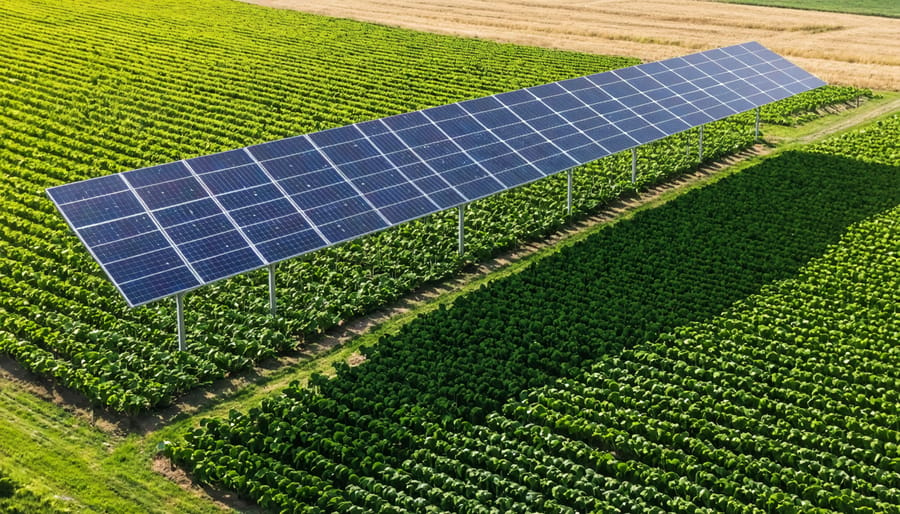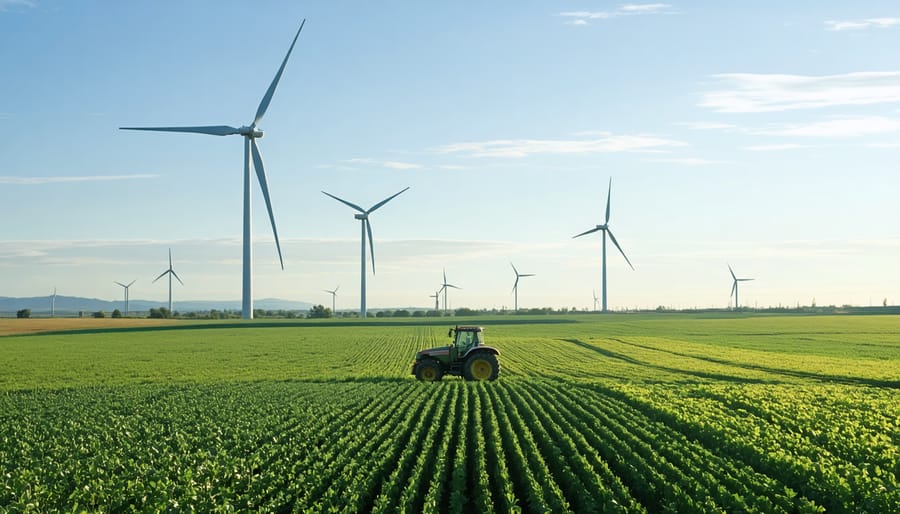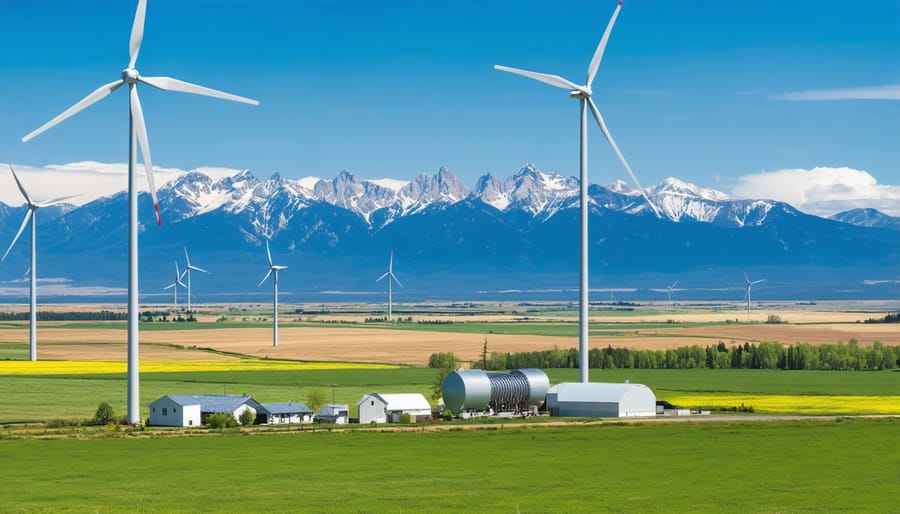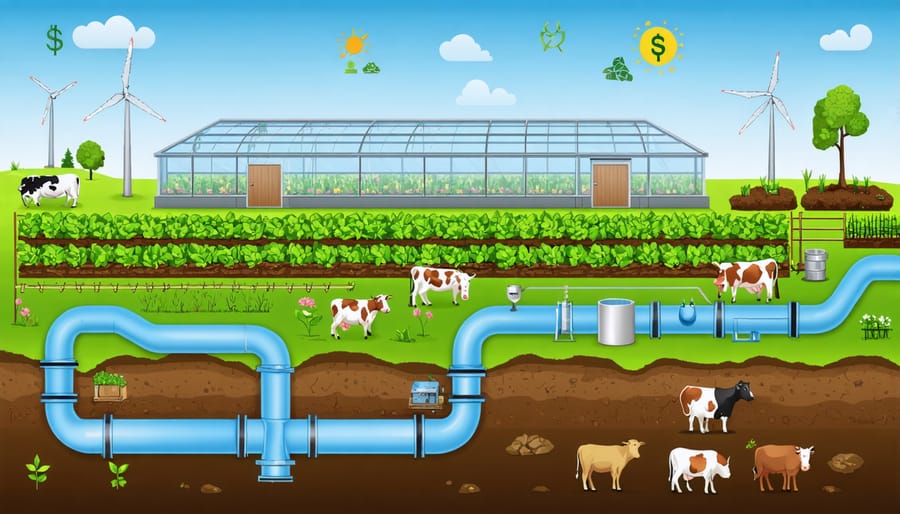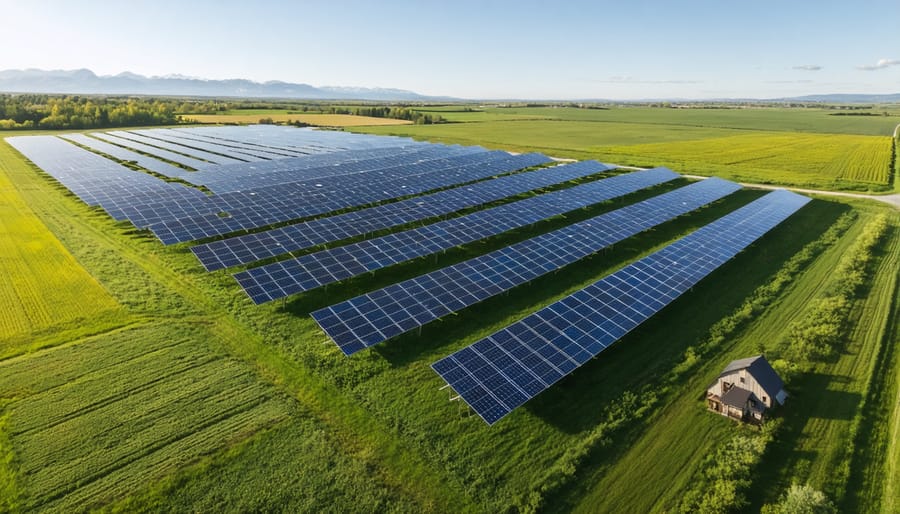Harness the untapped potential of your farmland by combining solar energy generation with traditional crop production. Modern agrivoltaic systems are already transforming Alberta farms, delivering up to 60% energy cost savings while maintaining crop yields. Agricultural solar integration isn’t just about placing panels in fields—it’s about creating resilient, dual-purpose landscapes that generate both food and clean energy.
Canadian farmers pioneering this approach have discovered innovative ways to maximize land use efficiency, from elevated panel designs that allow machinery access to strategic panel spacing that optimizes both sunlight distribution and moisture retention for crops. With solar installation costs dropping by 85% over the past decade and new federal incentives supporting clean energy adoption, the economics of agrivoltaics have never been more favorable for Canadian agricultural operations.
Whether you’re managing a small family farm or overseeing large-scale operations, integrating solar with agriculture offers a practical path to reduce operational costs, diversify farm income, and contribute to Canada’s sustainable farming future. This guide provides proven strategies for successfully implementing agrivoltaic systems while maintaining or enhancing agricultural productivity in our unique Canadian climate.
How Agrivoltaics Transform Canadian Farmland
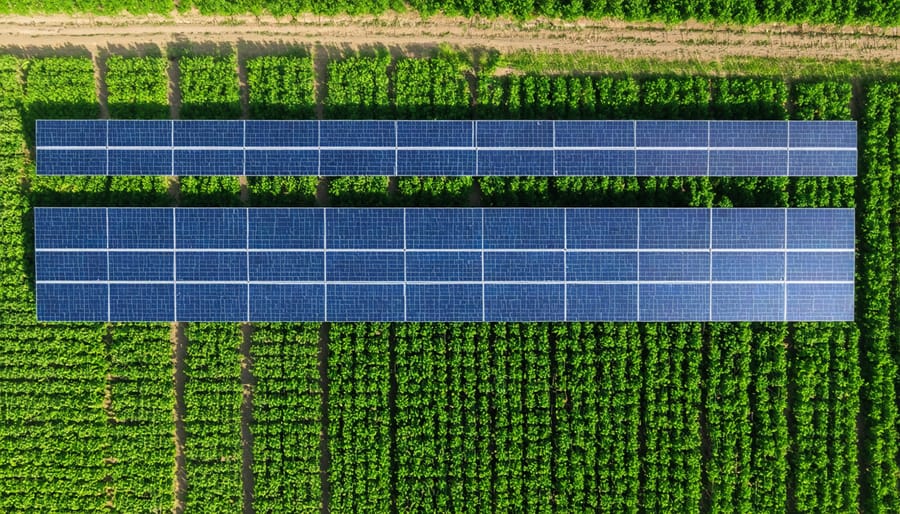
The Science Behind Solar Sharing
The science behind solar sharing reveals a fascinating synergy between crop production and solar energy systems. Research conducted at Alberta’s Olds College Smart Farm demonstrates that when panels are properly spaced and elevated, they create a microclimate that can actually benefit certain crops. The partial shade provided by solar panels helps reduce water evaporation by up to 30%, particularly valuable during our hot prairie summers.
The key lies in finding the right balance of sunlight. Most crops don’t require 100% of available sunlight to thrive – many perform well with 70-80% exposure. The diffused light created by panels can protect sensitive plants from intense midday sun while still allowing sufficient photosynthesis. This arrangement works especially well for shade-tolerant crops like leafy greens, root vegetables, and certain berries common to Canadian agriculture.
Temperature moderation beneath the panels also extends the growing season in some cases, offering protection from early frosts and extreme heat events. This creates a more resilient growing environment that’s particularly relevant for our changing climate conditions.
Success Stories from Alberta Farms
The Sunnyside Farm in Bassano has become a shining example of successful agrivoltaic implementation in Alberta. Owner Sarah Thompson installed a 100 kW solar array above her vegetable crops in 2021, reporting a 15% increase in overall land productivity. “The panels actually helped protect our lettuce and spinach during last summer’s heatwave,” Thompson explains, “and we’re seeing significant energy cost savings.”
In Strathmore, the Miller family’s dairy operation integrated a 200 kW system across 2 hectares of pasture land. Their solar meadow approach allows sheep to graze beneath the panels, maintaining dual-purpose land use while generating enough power to offset 80% of their farm’s electricity needs.
The Ross Brothers near Lethbridge pioneered a unique approach, installing bifacial solar panels above their berry crops. Their data shows a 20% increase in berry yield due to the optimized microclimate created by the panels, while generating 150,000 kWh annually. “The initial investment was significant,” notes Jim Ross, “but the combined benefits to our crops and energy bills made it worthwhile.”
Choosing the Right Crops for Agrivoltaic Systems
Best-Performing Crops Under Solar Panels
Research across Alberta and other Canadian provinces has identified several crops that thrive particularly well under solar panel installations. Root vegetables like potatoes and carrots have shown impressive yields, benefiting from the regulated soil moisture and temperature under panels. These crops typically require less direct sunlight and adapt well to partial shade conditions.
Leafy greens, including spinach, kale, and lettuce, have demonstrated exceptional performance in agrivoltaic systems. These crops often produce higher yields under panels compared to open-field cultivation, especially during hot summer months when partial shade prevents leaf burn and extends the growing season.
Cold-weather crops such as broccoli and cabbage have also shown promising results, with the added benefit of panel protection against early frost damage. Berry crops, particularly saskatoons and haskap, are emerging as excellent choices for Alberta farmers, as these native species naturally adapt to varying light conditions.
Recent trials at the Olds College Smart Farm have documented success with forage crops like alfalfa and timothy, showing only minimal yield reduction while providing valuable ground cover and soil stability. These findings are particularly relevant for livestock operators looking to maximize land use.
For grain producers, shorter varieties of wheat and barley have performed well in partial shade conditions, though careful panel spacing is crucial to maintain acceptable yields. The key is selecting crop varieties bred for lower light conditions and managing irrigation systems to take advantage of the modified microclimate created by the panels.
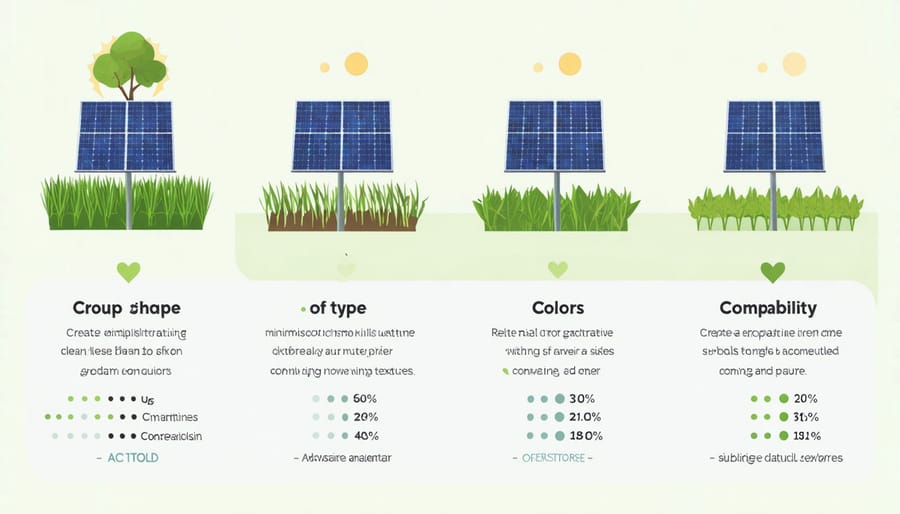
Seasonal Considerations for Alberta
Alberta’s unique climate requires careful planning for successful agrivoltaic implementation throughout the year. During the growing season from May to September, farmers can maximize the dual-use potential of their land by aligning crop selection with solar panel configurations. Spring planning should begin in March, focusing on crops that thrive in partial shade, such as leafy greens and root vegetables.
Summer months (June-August) present optimal conditions for solar energy generation, with Alberta receiving up to 16 hours of daylight. This period requires strategic panel positioning to protect heat-sensitive crops while maintaining energy production efficiency. Consider installing adjustable panels that can be tilted to provide more shade during peak heat periods.
Fall harvest timing (September-October) should account for equipment clearance beneath solar installations. Many Alberta farmers have found success with lower-growing crops that can be harvested before the first frost, typically in early October.
Winter preparations are crucial, with panel heights needing to accommodate snow accumulation while maintaining structural integrity. December through February requires regular snow removal from panels to maintain energy production, though the reduced daylight hours naturally lower expectations for power generation.
Year-round monitoring of soil moisture levels is essential, as solar panel arrangements can affect precipitation distribution and snow melt patterns. Many successful Alberta operations integrate moisture sensors to optimize irrigation scheduling across seasons, ensuring consistent crop development beneath the panels.
Financial Benefits and Support Programs
Government Incentives for Agrivoltaics
Canadian farmers interested in implementing agrivoltaic systems can access several government support programs and financial incentives. At the federal level, the Agricultural Clean Technology Program offers funding of up to $2 million for sustainable farming initiatives, including solar integration projects. The program specifically supports innovations that reduce greenhouse gas emissions while maintaining productive agricultural operations.
The Canada Greener Homes Grant, while primarily residential, has been expanded to include farm buildings, offering up to $5,000 for solar installations. In Alberta, farmers can benefit from the On-Farm Energy Management Program, which covers up to 50% of solar project costs to a maximum of $50,000.
Additional support comes through the Canadian Agricultural Partnership (CAP), a federal-provincial initiative providing grants and cost-sharing opportunities for sustainable farming practices. The Scientific Research and Experimental Development (SR&ED) tax incentive program offers tax credits for innovative agricultural projects, including agrivoltaic implementations.
Many rural municipalities also offer property tax incentives for agricultural land incorporating renewable energy systems. Farmers should consult their local agricultural extension office for region-specific programs and application assistance, as new incentives are regularly introduced to support sustainable farming practices.
Return on Investment Analysis
Recent studies of Alberta farms implementing agrivoltaic systems show promising returns on investment, with most operations recovering initial costs within 6-8 years. A 2022 case study of the Marshall Farm near Lethbridge demonstrated that their 200kW solar installation, integrated with canola production, achieved a 12% annual return on investment while maintaining 90% of traditional crop yields.
When considering farm energy solutions, the combined benefits of reduced electricity costs and sustained agricultural production create a compelling financial case. Analysis from the Alberta Agricultural Solar Program reveals that farms implementing solar systems typically save $7,000-$12,000 annually on energy costs, while qualifying for up to $50,000 in provincial grants.
Local farmer Sarah Thompson’s mixed-operation farm near Red Deer showcases these benefits. After installing a 150kW system in 2020, she reports an 85% reduction in electricity costs while successfully growing shade-tolerant crops beneath the panels. When factoring in current federal clean energy incentives and provincial rebates, her projected break-even point is just 5.5 years, with an estimated system lifespan of 25-30 years.
Implementation Guide for Your Farm
Site Assessment and Planning
Proper site assessment is crucial for successfully integrating solar installations with agricultural operations. Start by conducting a thorough evaluation of your land’s solar potential, including annual sun exposure, shading patterns, and topography. In Alberta, south-facing slopes with minimal obstruction typically offer optimal conditions for solar arrays.
Consider your existing agricultural activities and identify areas where solar installations would have minimal impact on crop production or livestock grazing. Soil quality assessment is essential – prioritize placing solar infrastructure on less productive land while preserving prime agricultural areas for farming.
Work with qualified solar professionals to analyze your farm’s electrical demands and determine appropriate system sizing. They can help create detailed site maps incorporating both agricultural and solar requirements, ensuring efficient use of available space.
Your implementation plan should address:
– Seasonal agricultural activities and their relationship to solar installation timing
– Access requirements for both farming equipment and solar maintenance
– Water management and drainage considerations
– Integration with existing irrigation systems
– Future expansion possibilities
– Local permitting and regulatory requirements
Many successful Alberta farmers have found that winter months are ideal for solar installation, minimizing disruption to growing seasons. Consider starting with a pilot project on a smaller land portion to test and optimize your approach before expanding.
Remember to engage with local agricultural extension services and solar experts during the planning phase – their combined expertise can help create a balanced plan that maximizes both energy generation and agricultural productivity.
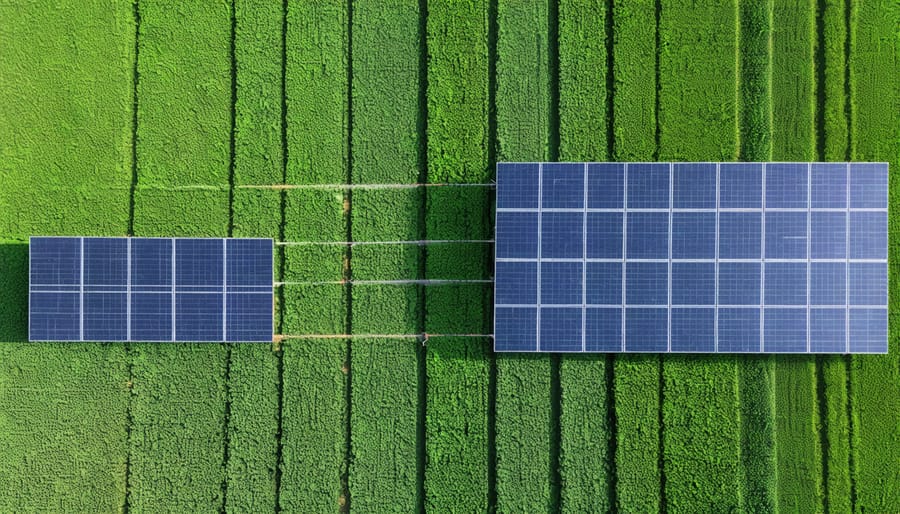
Equipment and Infrastructure Needs
Implementing a successful agrivoltaic system requires careful planning and specific equipment selection. The primary components include solar panels, mounting structures designed to optimize both sunlight penetration and crop access, and a comprehensive solar microgrid installation system.
For Alberta farmers, essential infrastructure includes adjustable racking systems that can withstand our prairie winds while maintaining appropriate height clearances (typically 3-4 metres) for agricultural machinery. The mounting structures must be corrosion-resistant and capable of supporting snow loads during winter months.
Key equipment requirements include:
– Bifacial solar panels for maximum light utilization
– Weather monitoring stations
– Irrigation systems modified for panel compatibility
– Enhanced drainage infrastructure
– Access roads for maintenance
– Power inverters and storage systems
– Safety equipment for maintenance work
Additional considerations include fencing for livestock protection, communication systems for remote monitoring, and specialized agricultural equipment designed to operate around solar installations. Many Alberta farmers have found success with mobile panel systems that can be adjusted seasonally, though these require more robust foundation work and control mechanisms.
Working with Local Installers
When selecting a solar installer for your agricultural project, start by creating a shortlist of local contractors who have experience with farm installations. Look for companies certified by the Canadian Solar Industries Association (CanSIA) and ask about their experience with agricultural projects specifically. Request references from other farmers in your area who have implemented similar systems.
Before signing any contracts, ensure your chosen installer understands both solar technology and agricultural operations. They should be willing to work around your farming schedule and demonstrate knowledge of how solar installations can complement your existing agricultural activities. Ask about their experience with permits and regional regulations, as well as their familiarity with available government incentives and grants.
Consider hosting site visits with multiple installers to compare their approaches and recommendations. A good installer will assess your farm’s energy needs, available space, and soil conditions while considering your agricultural priorities. They should provide detailed proposals that include system specifications, timeline estimates, and clear cost breakdowns.
Establish clear communication channels and ensure the installer has a solid plan for minimizing disruption to your farming operations during installation. Request information about maintenance services, warranty terms, and ongoing support to ensure your agrivoltaic system remains efficient long-term.
The integration of solar energy with agriculture represents a promising opportunity for Canadian farmers to diversify their income while maintaining productive farmland. Throughout this guide, we’ve explored how agrivoltaics can enhance farm operations through dual land use, increased crop yields in certain conditions, and reliable energy generation.
For Alberta farmers considering this innovative approach, the next steps are clear. Start by conducting a thorough site assessment and consulting with local solar installers who understand agricultural applications. Connect with your municipal authorities to understand zoning requirements and available permits. Remember that several government incentives and grants are available to support your transition to solar energy, including the Canada Greener Homes Grant and provincial agricultural sustainability programs.
The success stories from fellow Canadian farmers demonstrate that solar and agriculture can work hand in hand, particularly in our unique climate conditions. Whether you’re considering a small installation for farm building operations or a larger dual-use system, the key is to start with clear goals and a solid implementation plan.
Resources are available through provincial agricultural extension services, renewable energy associations, and local farming cooperatives. Consider joining agricultural solar working groups or attending workshops to learn from others’ experiences. With proper planning and support, integrating solar power into your farming operation can contribute to both environmental sustainability and long-term financial stability.
For personalized guidance, reach out to your local agricultural advisor or renewable energy consultant to begin your solar farming journey.

